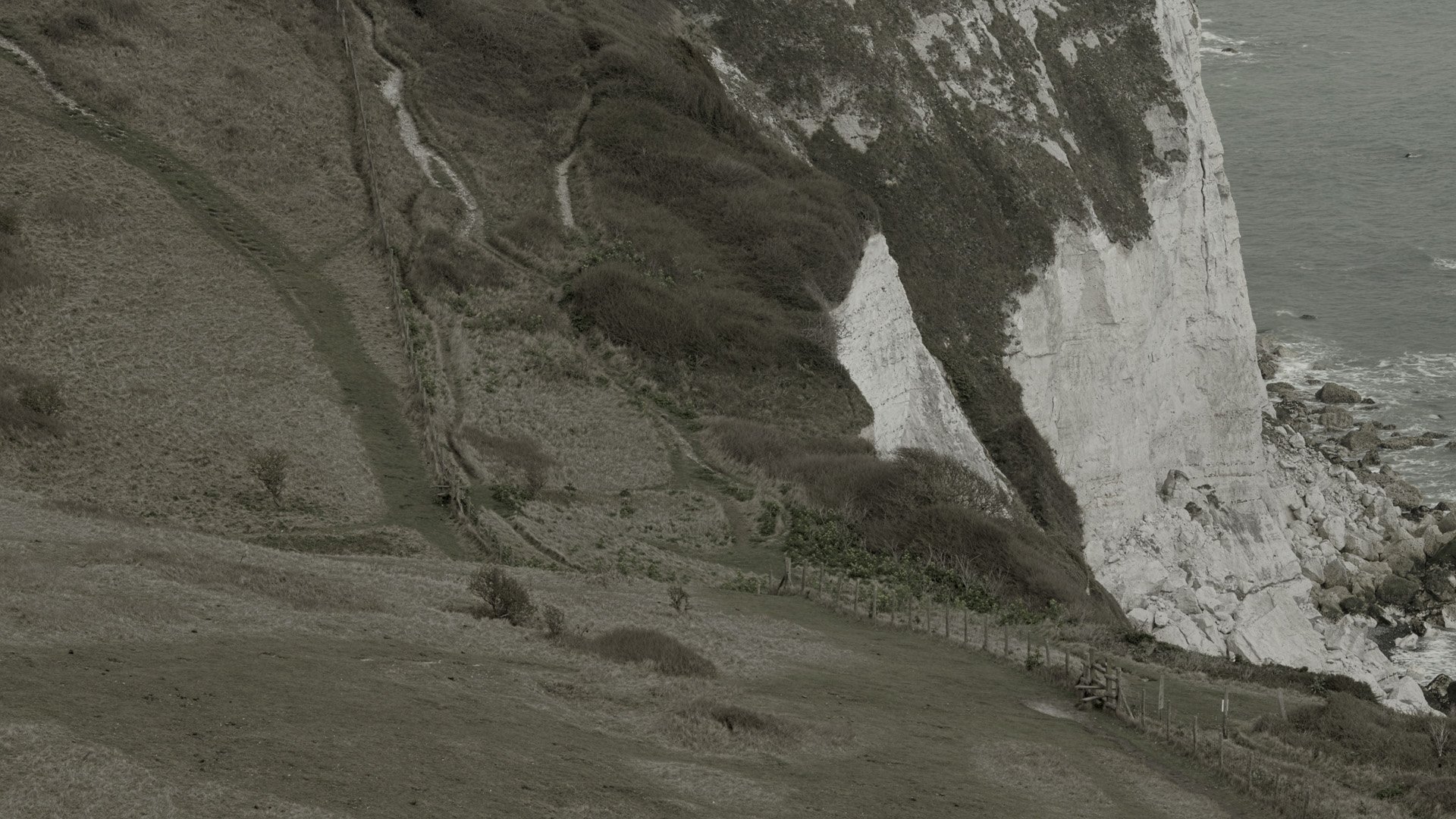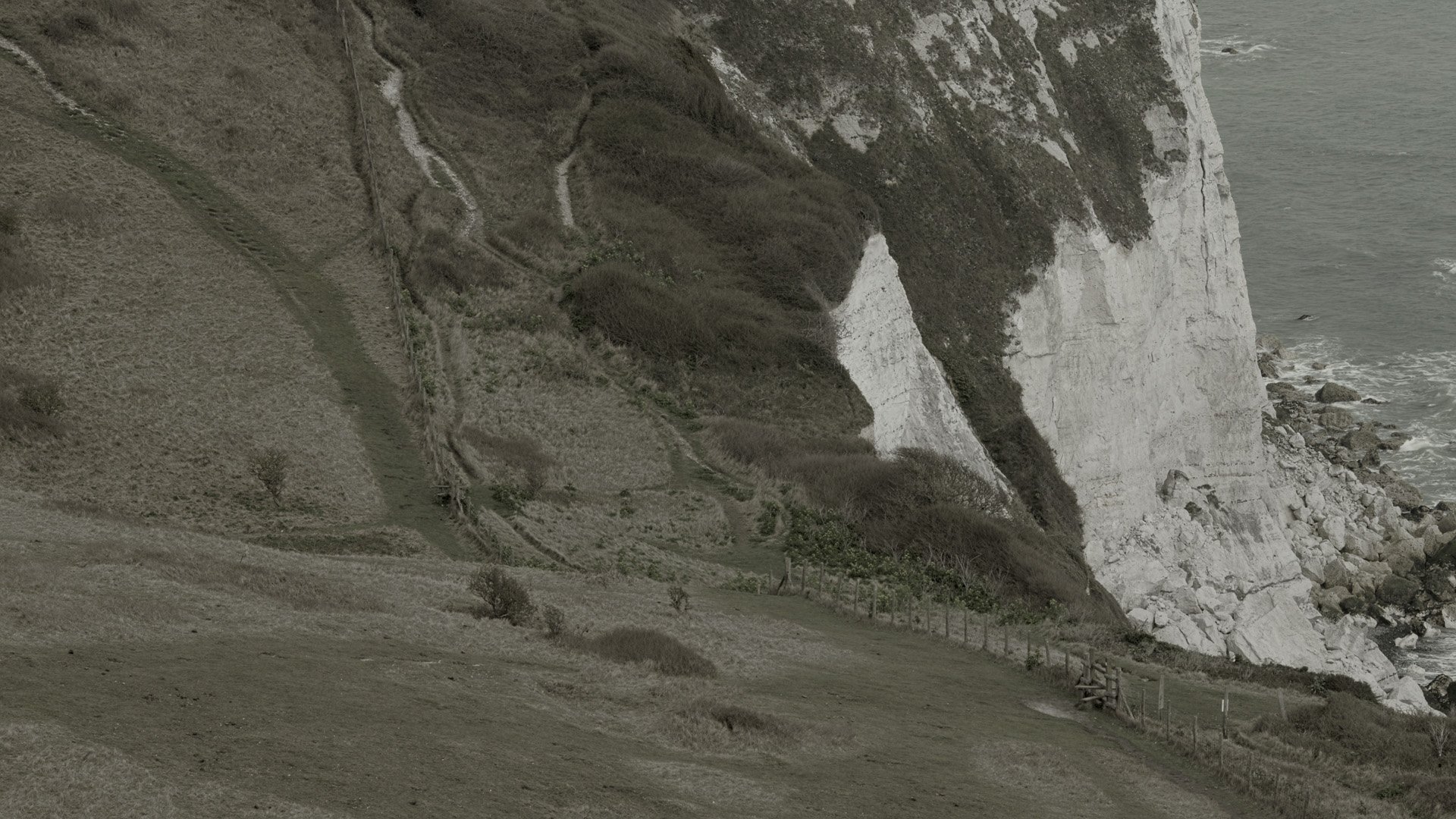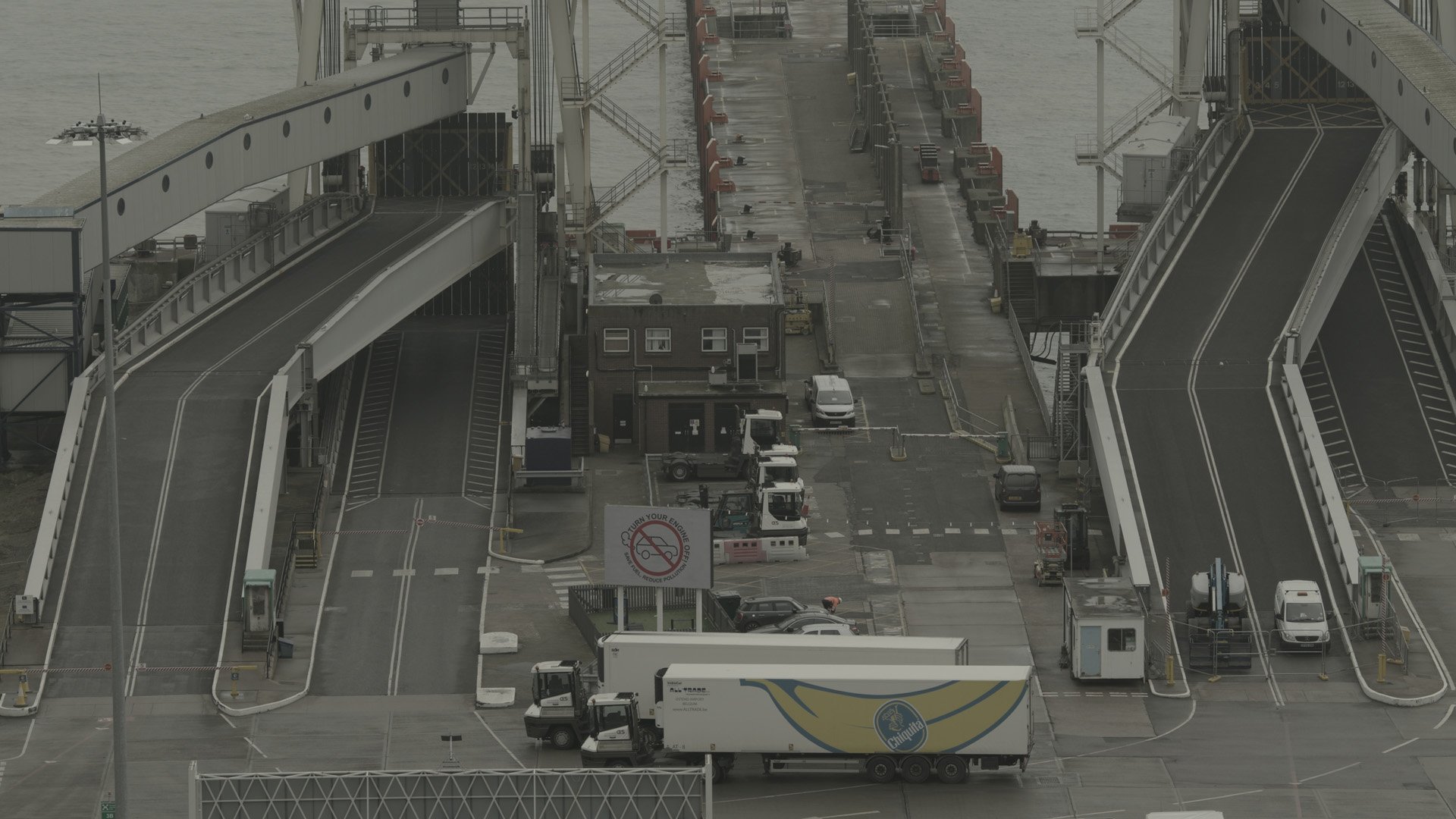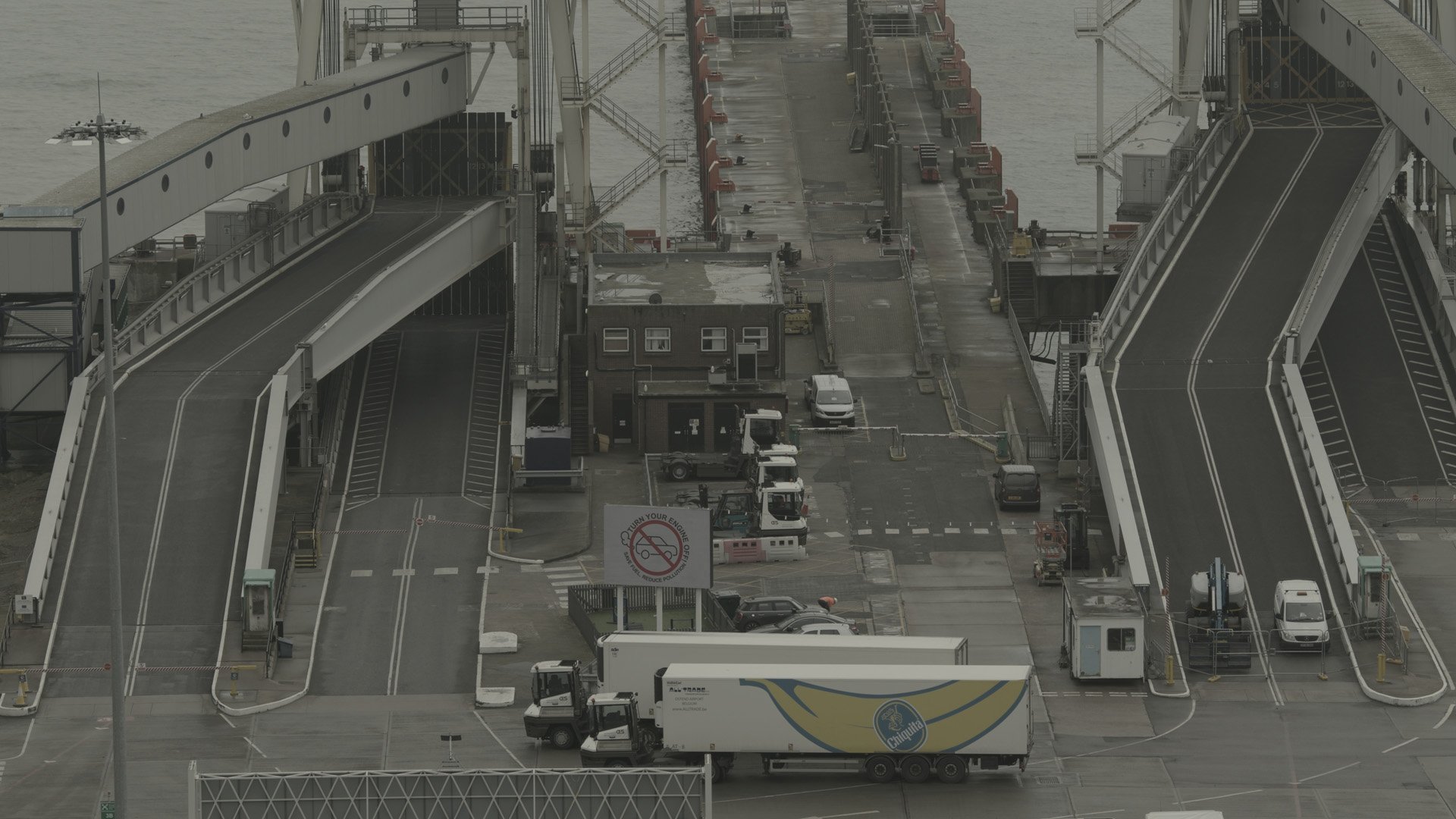Above: Images from pre-production/ research of Vanishing Point.
All rights reserved © Duncan Whitley 2023
Vanishing Point is a film project in development combining speculative fiction, slow cinema and observational documentary to explore interconnections between the themes of landscape, atmospheres and borders in contemporary Britain.
Research & development:
R&D was supported through a 12-month residency at the department of Film & Television Studies at University of Warwick. Research included development of an expanded definition of the ‘road movie’ (or journey genre) of cinema as a vehicle to explore political atmospheres of post-Brexit Britain, and collaborative research into the visuality and spectacle of border politics with members of the BREM (Borders Race Ethnicity and Migrations) network at University of Warwick.
Extract from research residency blog:
Bibby Stockholm, pre-production image for Vanishing Point. All rights reserved © Duncan Whitley 2023
Observing the Bibby Stockholm (August 2023)
Seeing the Bibby Stockholm accommodation barge in its berth at the Isle of Portland, reveals more about it than can be gleaned from the raft of front page news articles in the national press, since the ship’s arrival in Portland on 18th July 2023.
Portland is a small island with a population of 13,417, attached to mainland UK by a tombolo which supports the only road on and off the island. It is home to one of the largest human-made harbours in the world, and also to a people fiercely proud of its local heritage and customs, of whom almost 94% are white. Since the UK government announced its plans on April 5th 2023 to house 500 asylum seekers on a floating barge docked at Portland Port, communities on Portland have been unsurprisingly concerned about the proposals, with a number of discussion groups forming on Facebook and other social media platforms, dedicated to sharing information about the Bibby Stockholm. Whilst many people living locally expressed concern for the well-being of the future inhabitants of the accommodation ship, responses to the announcement also channelled anti-immigrant sentiment, often echoing the language used by the then Home Secretary Suella Braverman, who has repeatedly used the term “invasion” to paint a picture of an “existential threat” posed to British values and culture by “illegal immigration”. Weymouth and Portland have since become a focus for far-right groups such as Patriotic Alternative, with local councillors and businesses receiving threatening letters (allegedly from members of Britain First). The berthing of the Bibby Stockholm off the Isle of Portland has thus become a focal point of both local and national debate, polarising opinion and heightening sensitivities around immigration and border politics and nationhood, and feeding into a toxic post-Brexit atmosphere of nationhood.
The Bibby Stockholm is only visible from the Verne Citadel, now HM Prison The Verne, built in the late C19th to protect Portland Harbour which it overlooks from a hill on the north-east side of the island. The floating barge is moored off a L-shaped jetty in Portland Port, a privately-owned commercial space serving military vessels, cargo vessels and cruise ships. Across on the next jetty an ocean liner is moored, billowing smoke from its huge stacks, and further up from that a pair of Royal Navy warships. Small tugs and Portland Port Police boats move through the waters surrounding the accommodation ship, contributing to the low frequency rumble of ship engines which emanate from the harbour down below. Alongside the barge is a large, industrial structure housing a crane, which is used to load and unload goods from arriving cargo ships. Across on the opposite jetty is a warehouse, and other port furniture, the scale of which comes into focus through the port workers in their hi-viz jackets who appear like ants from the viewing point up by the Verne. Way beyond the jetties and enclosing the harbour to the east is the Portland Breakwater, with its array of disused military buildings once occupied as searchlight emplacements, gun and mine-watching posts. The construction of breakwaters began in 1849, following the building of HM Prison Portland (now the Young Offenders Institute) to provide human labour for the project, with convict labour providing 10,000 tons of stone per week for use on the breakwaters.
Coincidentally, the Bibby Stockholm is moored in exactly the same location as Portland’s controversial prison ship, HMP Weare, was once berthed. Operating as an adult male Category C prison until 2006, HMP Weare was sold to the UK government by British company Bibby Line in 1994 (the same business, now renamed Bibby Marine, who currently lease the Bibby Stockholm) who had bought the vessel in 1982 and named it ‘Bibby Resolution’. Stood outside the walls of HMP The Verne, scanning down into the port beyond the naval cemetery, these multiple histories begin to form a strange poetry of place, which informs the austere architecture of the floating accommodation ship below.
The closest you can get to the Bibby Stockholm on foot is the entrance to the highly-securitised Portland Port from Castletown. When I visit in the evening, the Castletown neighbourhood feels eerily quiet. There is no one in the streets, just a group of teenagers amusing themselves by the mariner and the occasional roar of a lone car revved up to the max. Although the area has undergone a deal of regeneration in recent years, it is still haunted by the skeletal, concrete ex-naval accommodation block, which conjures images of Castletown’s busy, bustling past. With the naval communities long gone, the area feels rather remote from the rest of Portland and not particularly homely.
The inhabitants of the barge are permitted to go outside at any time, but as soon as they step off the ship they are in a securitised zone. According to Portland Port, “when on port property they will be kept on the Bibby Stockholm or in a secure compound adjacent to the barge” (‘An Open Letter to Bibby Marine’, Refugee Council, July 2023). In recent Guardian article, one inhabitant on the barge is quoted as saying, “Even to use the fresh air, you have to go through the inspection every time and go to the small yard with high fences and go through the X-ray machine again” (‘This is a prison: men tell of distressing conditions on Bibby Stockholm’, Guardian, October 2023).
If the Bibby Stockholm looks and feels like a prison, it is not entirely accidental (and in fact, the accommodation of asylum seekers in quasi-detention sites is not unique to the Bibby Stockholm, see for example Napier Barracks in Kent). Rather, it forms part of a wider set of punitive government policies which seek to cast asylum seekers as “illegal migrants” who would drain the resources of the British tax-payer, aligning with the creation of a “hostile environment”, in the words of Immigration Minister Robert Jenrick, “to prevent the UK becoming a magnet for asylum shoppers in Europe” (Home Office, 2023). The inhabitants of the accommodation ship face a double-hostility, firstly that of the actual living conditions through being housed in a private commercial-industrial-military securitised zone, with its heavy fuel-laden air and constant industrial noise, and secondly that of the perceptions with which they are met on the island, since this spectacle of detention symbolically evidences the asylum seeker as “illegal” or “criminal”. Thus the visiting men who will be temporarily accommodated on the Bibby Stockholm whilst awaiting the outcomes of their Asylum claims, are placed into tense relationships with the local community through being cast as (literally) peripheral to society, if not as an actual “threat” to local communities.
Recommended reading: ‘Bibby Stockholm: The Political Economy of Offshore Asylum Accommodation and Confinement’, Turner, J. Davies, T. Isakjee, A. Mayblin, L. Yemane, T. (2023)












